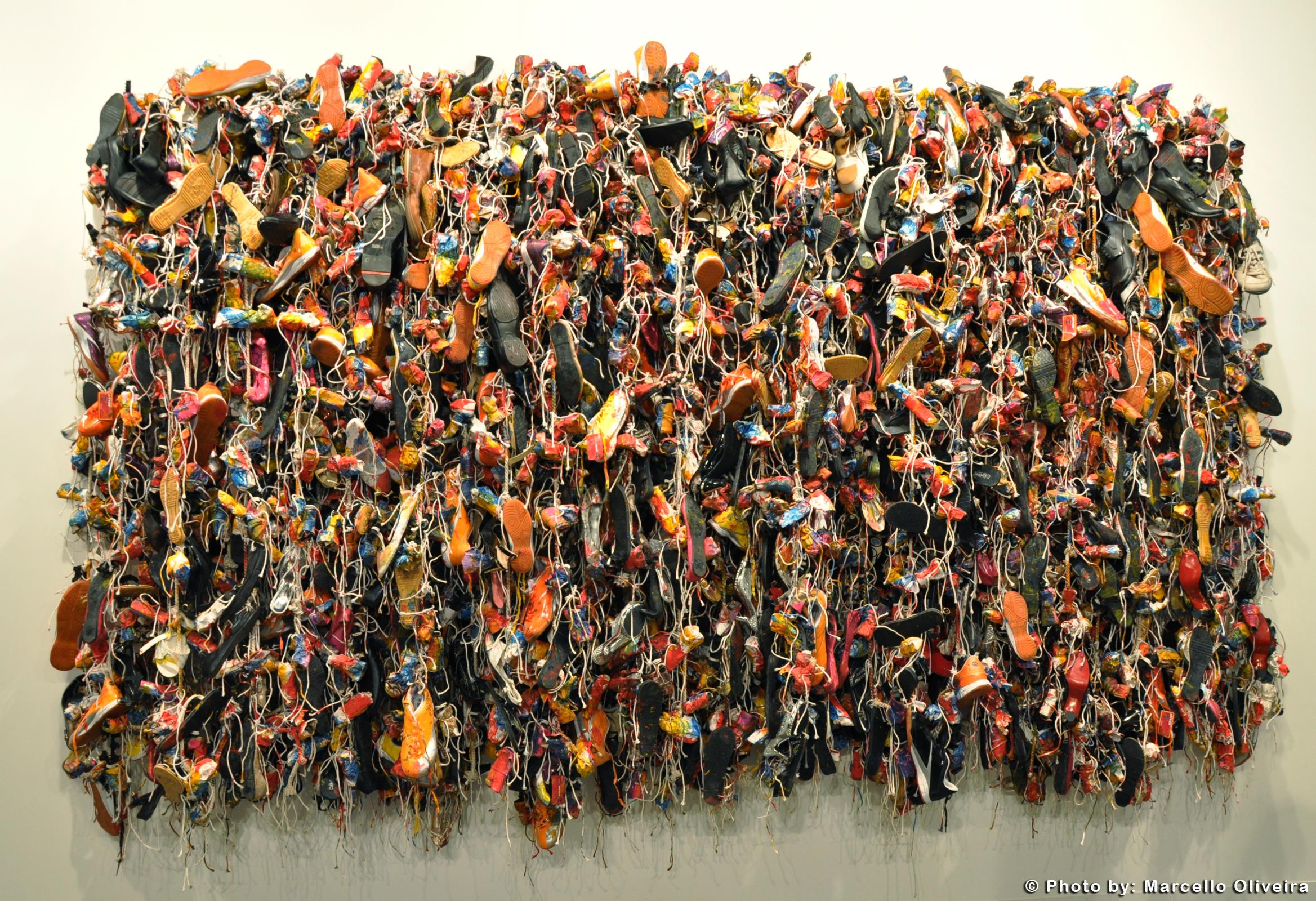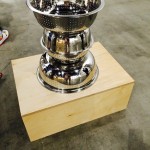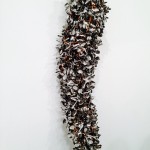Although the use of everyday objects in works of art was so persistent at Art Basel Miami that it bordered on cliche, there were an exciting number of sensibility-shifting works of art built from very humble materials.
A piece which drew me back several times was an epic collage/painting of shoes and sneakers by Hassan Sharif (b. 1951) from Dubai, U.A.E., shown by Alexander Gray Associates, New York. Sharif’s large 2014 piece, called “Ladies and Gentleman,” weaves together multitudes of shoes in a way that they become cultural artifacts, with themes of diaspora and immigration, as well as a blending of genders, running through the piece. At moments, I thought of the displays of shoes taken from concentration camp victims on view at Holocaust museums. Yet Sharif also captures the colorful verve of the shoes themselves, which always seem in motion even when jelled together. Both “Ladies and Gentleman” and Sharif’s Spoons No. 5 2014 jangle the viewer’s perception of the stability of everyday objects, as they escape their designated roles and become signifiers of consumption and how we treat each other.
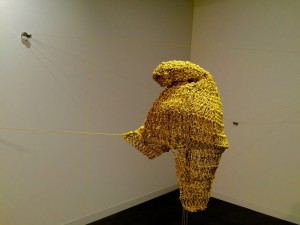 How an everyday thing (and the aspiration it symbolizes) disappeared was the theme of Fritzia Irizar’s on-site dramatization presented by Arredondo\Arozarena. The piece, Untitled (The disappearance of the symbol), shows the unraveling of a Phrygian cap. In ancient Phrygia (now Turkey) a Phrygian cap was donned by slaves who were liberated. The cap became a symbol of freedom during the French Revolution and was embossed on Mexican coins as that nation moved toward a republic. The symbol then disappeared. For the Art Basel exhibit, Irizar wove such a cap out of gold thread and created a series of pulleys that slowly unwove the cap until it completely disappeared by the end of the exhibition.
How an everyday thing (and the aspiration it symbolizes) disappeared was the theme of Fritzia Irizar’s on-site dramatization presented by Arredondo\Arozarena. The piece, Untitled (The disappearance of the symbol), shows the unraveling of a Phrygian cap. In ancient Phrygia (now Turkey) a Phrygian cap was donned by slaves who were liberated. The cap became a symbol of freedom during the French Revolution and was embossed on Mexican coins as that nation moved toward a republic. The symbol then disappeared. For the Art Basel exhibit, Irizar wove such a cap out of gold thread and created a series of pulleys that slowly unwove the cap until it completely disappeared by the end of the exhibition.
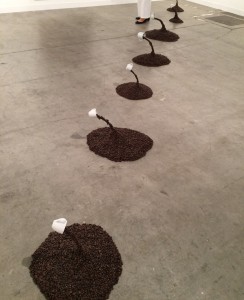 You’d think that pennies and coffee beans wouldn’t engage the eye, but witness Danish artist Nina Beier’s pieces presented by Standard (Oslo). The trail of coffee bean circles, each topped by a tiny cup, seemed to me to represent — and dignify — morning after morning after morning. And mounds of glistening, almost smiling, pennies, each topped by a water faucet, had a bit to say about the attraction and absurdity of wealth.
You’d think that pennies and coffee beans wouldn’t engage the eye, but witness Danish artist Nina Beier’s pieces presented by Standard (Oslo). The trail of coffee bean circles, each topped by a tiny cup, seemed to me to represent — and dignify — morning after morning after morning. And mounds of glistening, almost smiling, pennies, each topped by a water faucet, had a bit to say about the attraction and absurdity of wealth.
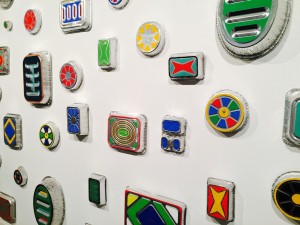 I’m not at all sure what California artist B. Wurtz has to say but he can make compelling art out of the most ordinary of objects. Metro Pictures showed his Untitled (pan paintings), a series of metal catering type-pans painted on the backs in vivid auto-like colors. He also showed a deceptively simple piece of three stacked colanders that held my attention amid all the clamor of Art Basel and put a grin on my face. In a show that featured works that used elaborately expensive materials, Wurtz’ work demonstrates that imaginative recycling can produce a huge impact.
I’m not at all sure what California artist B. Wurtz has to say but he can make compelling art out of the most ordinary of objects. Metro Pictures showed his Untitled (pan paintings), a series of metal catering type-pans painted on the backs in vivid auto-like colors. He also showed a deceptively simple piece of three stacked colanders that held my attention amid all the clamor of Art Basel and put a grin on my face. In a show that featured works that used elaborately expensive materials, Wurtz’ work demonstrates that imaginative recycling can produce a huge impact.


